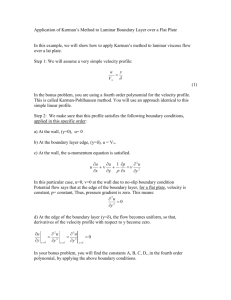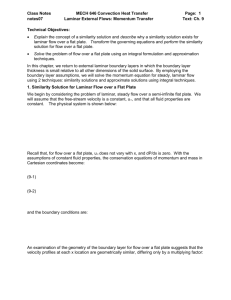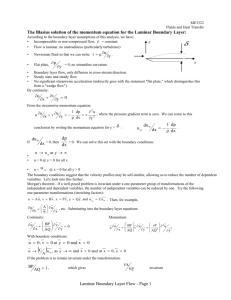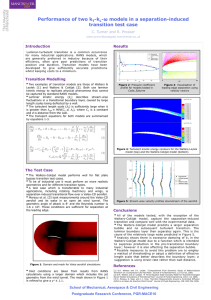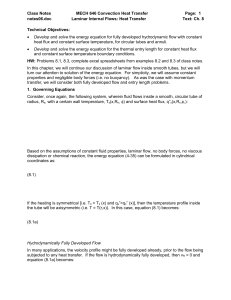notes08
advertisement
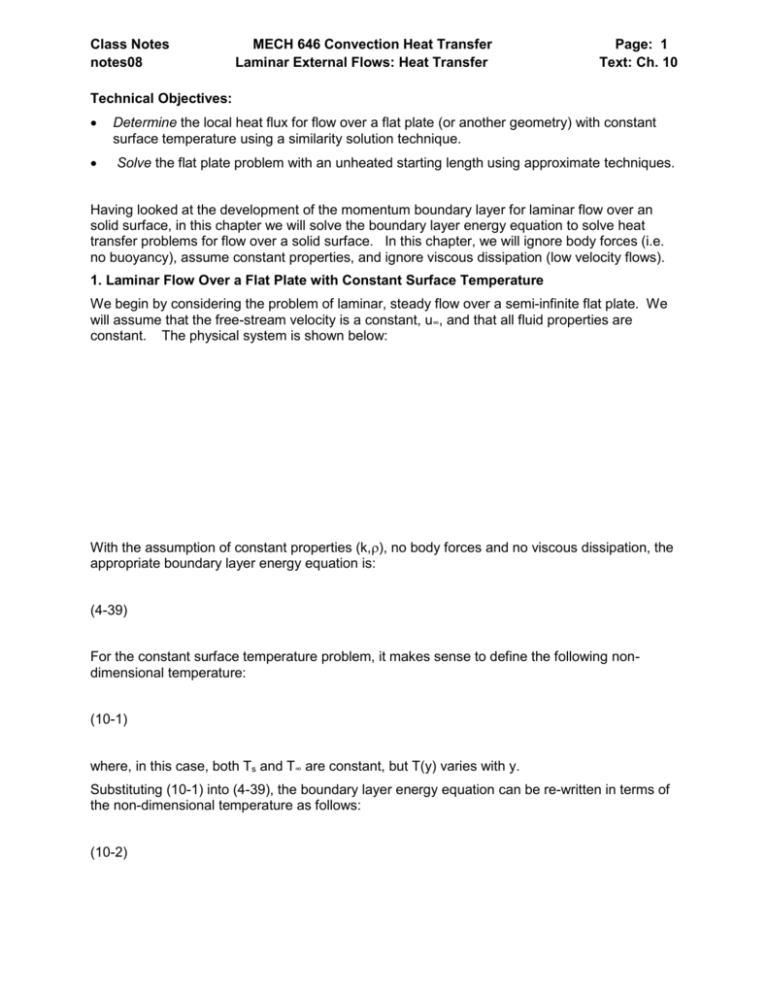
Class Notes notes08 MECH 646 Convection Heat Transfer Laminar External Flows: Heat Transfer Page: 1 Text: Ch. 10 Technical Objectives: Determine the local heat flux for flow over a flat plate (or another geometry) with constant surface temperature using a similarity solution technique. Solve the flat plate problem with an unheated starting length using approximate techniques. Having looked at the development of the momentum boundary layer for laminar flow over an solid surface, in this chapter we will solve the boundary layer energy equation to solve heat transfer problems for flow over a solid surface. In this chapter, we will ignore body forces (i.e. no buoyancy), assume constant properties, and ignore viscous dissipation (low velocity flows). 1. Laminar Flow Over a Flat Plate with Constant Surface Temperature We begin by considering the problem of laminar, steady flow over a semi-infinite flat plate. We will assume that the free-stream velocity is a constant, u∞, and that all fluid properties are constant. The physical system is shown below: With the assumption of constant properties (k,), no body forces and no viscous dissipation, the appropriate boundary layer energy equation is: (4-39) For the constant surface temperature problem, it makes sense to define the following nondimensional temperature: (10-1) where, in this case, both Ts and T∞ are constant, but T(y) varies with y. Substituting (10-1) into (4-39), the boundary layer energy equation can be re-written in terms of the non-dimensional temperature as follows: (10-2) Class Notes notes08 MECH 646 Convection Heat Transfer Laminar External Flows: Heat Transfer Page: 2 Text: Ch. 10 The boundary conditions for are as follows: Recall that we already solved the momentum equation for this same problem, and for the case of constant fluid properties, the energy and momentum equations are uncoupled. So, we already know the velocity profile everywhere in the flow. Note also, the similarity between (10-2) and the corresponding momentum equation (9-1): (9-1) 1.1 Solution for Flat Plate with Constant Ts for Special Case of Pr=1 For the special case of Pr=1, the same function will satisfy both (9-1) and (10-2), so for this special case, the problem is already solved! Specifically, the non-dimensional velocity and non-dimensional temperature profiles, in this case are similar and grow along the plate at the same rate and the solution to (10-2) becomes: (10-3) Note that for many gases such as air, Pr number is nearly 1, so this solution provides a good estimate for the heat transfer coefficient. 1.2. Solution for Flat Plate with Constant Ts for non-unity Prandtl Number Even for non-unity Prandtl number, the similarity between the energy and momentum equations suggests that we can seek a similarity solution exists for the energy equation with the same similarity variable . So, we will assume the following: (10-2a) So, assuming that is a similarity variable for x and y, we can attempt to transform the PDE (10-2) into an ODE by substituting in the following derivatives: Class Notes notes08 MECH 646 Convection Heat Transfer Laminar External Flows: Heat Transfer Page: 3 Text: Ch. 10 Substituting these derivatives into (10-2) results in the following: (10-4a) Recalling the definition of ’ = u/u∞ and invoking the conservation of mass to eliminate v: It can be shown that equation 10-4a can be reduced to the following: (10-4) where () is already known from the solution of the Blasius Equation (tabulated in Table 9-1). Equation (10-4) can now be solved along with the following boundary conditions: Class Notes notes08 MECH 646 Convection Heat Transfer Laminar External Flows: Heat Transfer Page: 4 Text: Ch. 10 Equation (10-4) can be solved directly by integrating with respect to . (10-5) Integrating a second time yields: (10-6) Applying the boundary condition (0) = 0, results in C2 = 0. Applying the boundary condition at infinity results in: (10-7) And, the final solution is: (10-8) The result seems a bit ugly, but since we already have the solution of , the integrals in (108) can be readily evaluated. Given , we can now evaluate the heat transfer coefficient, Nusselt number, etc. Class Notes notes08 MECH 646 Convection Heat Transfer Laminar External Flows: Heat Transfer Page: 5 Text: Ch. 10 The heat transfer coefficient can be evaluated from: (10-9a) Resulting in the following Nusselt number: (10-9b) Where ’(0) is already known (equation 10-7 above), resulting in: (10-9) which gives the local Nusselt number as a function of x along the surface of a flat plate with constant surface temperature Ts, for various Prantl number. The results of equation (10-9) are tabulated in Table 10-1. Over the range of 0.5 < Pr < 15, equation (10-9) can be approximated by the following equation: (10-10) Example 10.1. Air at 300 K flows with a velocity of 10 m/s over a 1 meter long flat plate which is maintained at a constant surface temperature of 600K. Calculate the temperature profile T(y) at x = 0.125, x=0.5 and x = 1 m. Make a plot of local Nusselt number as a function of x using the exact solution (10-9) and compare it to the approximate solution (10-10). Calculate the heat flux as a function of x along the plate. Class Notes notes08 MECH 646 Convection Heat Transfer Laminar External Flows: Heat Transfer Page: 6 Text: Ch. 10 Given the local Nusselt number from equation (10-9) or (10-10), it is possible to evaluate an average heat transfer coefficient for the entire plate: (10-14) (10-15) 2. Laminar Flow Over a Wedge Shaped Body with Constant Surface Temperature Recall in Chapter 9, we looked briefly at the solution of the momentum equation for flow over a wedge shaped body. For this class of flows, the free stream velocity varies with x as follows: Class Notes notes08 MECH 646 Convection Heat Transfer Laminar External Flows: Heat Transfer Page: 7 Text: Ch. 10 The solution to this problem can be obtained in a similar manner to the flat plate. Specifically, we start with the same energy equation: (10-2) Since a similarity solution was obtained for the momentum equation, it is possible to transform (10-2) in a manner similar to the flat plate solution above, resulting in the following: (10-4a) Solutions to equation (10-4a) are tabulated in Table 10-2 for various values of m. 2.1 Two-Dimensional Stagnation Point Heat Transfer As an example example, consider the stagnation flow of air (Pr = 0.7) into a flat plate. In this case, = and m= 1 and from Table 10-2 we have the following: Note that, in this case, u∞ is varying with x, so we have to take that into account in our Rex calculation: (10-17a) So, for stagnation flow, we find that the local heat transfer coefficient hx does not vary with x! Class Notes notes08 MECH 646 Convection Heat Transfer Laminar External Flows: Heat Transfer Page: 8 Text: Ch. 10 The average heat transfer coefficient can be evaluated by integrating (10-17a) with respect to x as follows: (10-17b) An approximate solution for the stagnation flow problem (m=1) for Prandtl numbers near unity (i.e. air) is found to be: (10-18) 2.2 Heat Transfer near the Stagnation Point of a Cylinder or Sphere Equation (10-18) can also be used to approximate the heat transfer in the vicinity of the stagnation point of a cylinder: where x is defined as the local distance along the surface from the stagnation point. In order to make use of (10-18) we need to know the variation of u∞ with respect to x. For a cylinder, the local free stream velocity (for x<<R) is found to be: (10-20) Substituting (10-20) into (10-18), we get: (10-22a) Class Notes notes08 MECH 646 Convection Heat Transfer Laminar External Flows: Heat Transfer Page: 9 Text: Ch. 10 Multiplying through by the radius of the cylinder, R, we get: (10-22) which gives the average Nusselt number near the stagnation point of a cylinder in cross flow. Similarly, for flow over a sphere, it is possible to perform a transformation of coordinates to solve for the heat transfer in the vicinity of a three-dimensional, axisymmetric stagnation point, such as that exists for flow over a sphere. In this case the solution for the local Nusselt number is: (10-19) Once again, in order to use equation (10-19) we need to know the variation of u∞ with respect to x. For a sphere, the local free stream velocity (for x<<R) is found to be: (10-21) Substituting (10-21) into (10-19) yields the solution for average Nusselt number near the stagnation point of a sphere: (10-23) 3. Approximate Solutions Using the Energy Integral Equation: Flow Over a Flat Plate with Unheated Starting Length Recall from Chapter 9 that it is possible to solve the integral form of the momentum equation by assuming a form of the velocity profile within the boundary layer. Similarly, we can solve the integral form of the energy equation by assuming a form of the temperature profile in the thermal boundary layer. As an example of this technique, we seek a solution for flow over a flat plate, with constant free stream velocity, and an unheated starting length 0 < x < wherein the surface temperature is equal to the ambient temperature. At x > the temperature suddenly changes to Ts. Class Notes notes08 MECH 646 Convection Heat Transfer Laminar External Flows: Heat Transfer Page: 10 Text: Ch. 10 Note that, in this case, the thermal boundary layer (x) does not begin to develop until the point at which the surface temperature changes to Ts, whereas the momentum boundary layer (x) starts at the leading edge. Recall that the cubic polynomial for the velocity profile was chosen because the differential form of the momentum equation requires that the d2u/dy2 go to zero at the surface: (9-32) Similarly, examination of equation (10-4), shows that d2/dy2 must also go to zero at the surface: Accordingly, it can be shown that an appropriate approximate form of the non-dimensional temperature profile is: (10-25) where, is the thermal boundary layer thickness, which varies with x. Note that, once again, for the approximate solution,(x) has a finite value, which is not the case for the exact solution. Equations (9-32) and (10-25) can now be substituted into the integral energy equation (5-21): (5-21) Where 2 was defined as the enthalpy thickness as follows: (5-15) Substituting (9-23) and (10-25) into (5-21) yields: Class Notes notes08 MECH 646 Convection Heat Transfer Laminar External Flows: Heat Transfer Page: 11 Text: Ch. 10 Expanding the left hand side and substituting in for dT/dy at y=0 on the right hand side yields: (10-26a) Next, we define r as the ratio of the thermal boundary layer to the momentum boundary layer,: Substituting r into (10-26a) (10-26b) Class Notes notes08 MECH 646 Convection Heat Transfer Laminar External Flows: Heat Transfer Page: 12 Text: Ch. 10 Next, if we restrict ourselves to r < 1 (keep in mind what this assumption means physically!), we can assume that r2 <<1 and (10-26b) becomes: (10-26c) But, we already have solutions for (x) and d/dx from the Chapter 9: (9-33a) (9-33) Substituting these into (10-26c) yields: (10-26d) Equation (10-26d) is an ordinary differential equation for r with respect to x, which can be solved as follows: (10-26d) Class Notes notes08 MECH 646 Convection Heat Transfer Laminar External Flows: Heat Transfer Page: 13 Text: Ch. 10 Now returning to our initial problem: So, our boundary condition for r(x) is: Which allows us to solve for the integration constant, C. The final result for r(x) is: (10-26) Where is the length of the unheated starting length. Note that this solution can also be used as an approximate solution for the problem with no unheated starting length (=0), in which case the solution becomes. (10-27) Equation (10-27) suggests that for Pr = 1, the thermal and momentum boundary layers are identical. For Pr >1, the thermal boundary layer is thinner than the momentum boundary layer. Keep in mind that the solution to (10-26) assumed that r <1, so it is not really applicable to Pr <1, although it seems to work ok for Pr > 0.5. Given the solution for r(x), we now know (x) as well as (x), so we can solve for the local heat transfer coefficient hx: (10-28a) Class Notes notes08 MECH 646 Convection Heat Transfer Laminar External Flows: Heat Transfer Page: 14 Text: Ch. 10 Substituting r(x) from (10-27) and (x) from (9-33) yields: (10-28b) And, finally, we can define a local Nux as: (10-28) Which is identical to the approximate solution for no unheated starting length. Example 10-2. Air at 300 K flows with a velocity of 10 m/s over a 1 meter long flat plate. The first 0.5 m is maintained at a constant surface temperature of 300K and the second 0.5 m which is maintained at a constant surface temperature of 600K. Calculate the temperature profile T(y) at x = 0.6, x=0.8 and x = 1 m. Make a plot of thermal boundary layer (x), the momentum boundary layer (x) and calculate the Nusselt number as a function of x along the plate. HW Problems: 10.1, 10.2, 10.9
